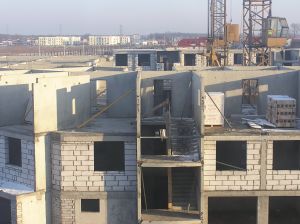The Commerce Department data released on August 19 suggests that, looking at a rolling 12-month total of multifamily starts without any seasonal adjustment, construction has hit its highest level since 1989 for the year ending in July.
This is less significant for economic growth than single-family homes, which have a bigger multiplier effect on both consumer spending and job growth, the Wall Street Journal reports.
“We will take what economic activity we can get, but our housing market model was designed in the U.S. to build a lot of single-family homes for owners, not multifamily homes for renters,” Diane Swonk, chief economist of Mesirow Financial, wrote Tuesday on the company's blog.
The boost to apartment construction, however, suggests that job gains are encouraging the creation of households, and that consumers' needs will require more construction, both for renters or for owners.
Renting has become popular, at least in part, because many Americans cannot afford the down payment for a house or can't get a mortgage, and others prefer the flexibility that comes with a lease.
Soon, however, rising rents could encourage renters to buy homes. A Labor Department report notes that rents were rising at their fastest pace in five years this July, up 3.3% from last year.
With apartment construction hitting a 25-year high, it's not surprising that apartment company stocks have been doing well. Shares of Equity Residential (EQR -0.13%) and AvalonBay Communities (AVB +0.22%) closed Tuesday at their highest levels since 1993 and 1994, when the companies went public, respectively.
Related Stories
| Oct 13, 2010
Editorial
The AEC industry shares a widespread obsession with the new. New is fresh. New is youthful. New is cool. But “old” or “slightly used” can be financially profitable and professionally rewarding, too.
| Oct 13, 2010
Test run on the HP Z200 SFF Good Value in a Small Package
Contributing Editor Jeff Yoders tests a new small-form factor, workstation-class desktop in Hewlett-Packard’s line that combines performance of its minitower machine with a smaller chassis and a lower price.
| Oct 13, 2010
Prefab Trailblazer
The $137 million, 12-story, 500,000-sf Miami Valley Hospital cardiac center, Dayton, Ohio, is the first major hospital project in the U.S. to have made extensive use of prefabricated components in its design and construction.
| Oct 13, 2010
Thought Leader
Sundra L. Ryce, President and CEO of SLR Contracting & Service Company, Buffalo, N.Y., talks about her firm’s success in new construction, renovation, CM, and design-build projects for the Navy, Air Force, and Buffalo Public Schools.
| Oct 13, 2010
Hospital tower gets modern makeover
The Wellmont Holston Valley Medical Center in Kingsport, Tenn., expanded its D unit, a project that includes a 243,443-sf addition with a 12-room operating suite, a 36-bed intensive care unit, and an enlarged emergency department.
| Oct 13, 2010
Modern office design accentuates skyline views
Intercontinental|Exchange, a Chicago-based financial firm, hired design/engineering firm Epstein to create a modern, new 31st-floor headquarters.
| Oct 13, 2010
Hospital and clinic join for better patient care
Designed by HGA Architects and Engineers, the two-story Owatonna (Minn.) Hospital, owned by Allina Hospitals and Clinics, connects to a newly expanded clinic owned by Mayo Health System to create a single facility for inpatient and outpatient care.
| Oct 13, 2010
Biloxi’s convention center bigger, better after Katrina
The Mississippi Coast Coliseum and Convention Center in Biloxi is once again open for business following a renovation and expansion necessitated by Hurricane Katrina.
| Oct 13, 2010
Tower commemorates Lewis & Clark’s historic expedition
The $4.8 million Lewis and Clark Confluence Tower in Hartford, Ill., commemorates explorers Meriwether Lewis and William Clark at the point where their trek to the Pacific Ocean began—the confluence of the Mississippi and Missouri Rivers.
| Oct 13, 2010
Maryland replacement hospital expands care, changes name
The new $120 million Meritus Regional Medical Center in Hagerstown, Md., has 267 beds, 17 operating rooms with high-resolution video screens, a special care level II nursery, and an emergency room with 53 treatment rooms, two trauma rooms, and two cardiac rooms.
















